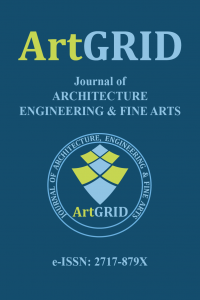COVID-19 ÖNCESİ VE SONRASI TÜRKİYE'DE KENTSEL İŞİTSEL PEYZAJ DEĞİŞİMLERİ: ESKİŞEHİR, BİR ANADOLU KENTİ
Türkiye'de alınan Covid-19 önlemleri doğrultusunda günlük hayatta bazı değişiklikler olmuş ve bu değişiklikler akustik ortamı özellikle baskın ses türü ve ses seviyesi açısından etkilemiştir. Devlet tarafından alınan önlemler sonucunda günlük hayatta meydana gelen değişikliklerin ses ortam üzerindeki etkilerini ses düzeyi, ses türleri ve işitsel peyzaj bileşenleri aracılığıyla incelemek amacıyla yapılan çalışmada örnek şehir olan Eskişehir'in şehir merkezindeki ticari-rekreasyon alanları ile tarihi-turistik alanlardaki akustik ortamda Covid-19 öncesi ve sonrasında meydana gelen değişimler incelenmiş ve karşılaştırmalı olarak değerlendirilmiştir. Covid-19 öncesi LO-FI akustik ortamda var olan ancak maskelenen sesler (özellikle doğal sesler), pandemi sonrası düşen ses seviyesi (5 ila 10 dBA) ile oluşan HI-FI akustik ortamında duyulabilir hale gelmiş ve bu sesler ön plan sesleri ve sembol sesler arasında yerini almıştır. Kentsel alanları tanımlayan sembol sesler pandemi öncesinde işleve göre alan kullanımından kaynaklanan seslerden oluşurken, pandemi boyunca doğal seslere dönüşmüştür.
Anahtar Kelimeler:
Covid-19, kentsel işitsel peyzaj, Eskişehir, Türkiye
URBAN SOUNDSCAPE CHANGES IN TURKEY BEFORE AND AFTER COVID-19: ESKİŞEHİR, AN ANATOLIAN CITY
In line with the Covid-19 measures taken in Turkey, there have been some changes in daily life and these changes affected the acoustic environment particularly in terms of dominant sound type and sound level. In the study conducted to examine the effects of changes in daily life as a result of the measures taken by the state on the sound environment, through sound level, sound types and soundscape components, the changes in the acoustic environment in commercial-recreational areas, as well as historical-touristic areas at the city center of the sample city Eskişehir, Turkey before and after Covid-19, were reviewed and evaluated by comparison. Before Covid-19, the sounds that existed but masked in the LO-FI acoustic environment (especially the natural sounds) became audible in the HI-FI acoustic environment created with the lowered sound level after pandemic (5 to 10 dBA), and they took their place among the keynotes and soundmarks. While the soundmarks that define urban areas consisted of the sounds arising from the area usage by function before the pandemic, they turned into natural sounds throughout the pandemic.
Keywords:
Covid-19, urban soundscape, Eskişehir, Turkey,
___
- Acoucité, Sound Environment Observatory. (2020). Lockdownduring Covid-19 pandemic: Impact on Sound Environment (Summary Report, version 11th June 2020), Lyon: Acoucité, 2020.
- Aletta F., Brinchi S., Carrese S., Gemma A., Guattari C., Mannini L., et al., (2020). Analysing urban trafic volumes and mapping noise emissions in Rome (Italy) in the context of containment measures for the COVID-19 disease, Noise Mapp., 7.1. DOI:10.1515/noise-2020-0010.
- Aletta, F., Osborn, D. (2020). The Covid-19 global challenge and its implications for the Environment – what are we learning, UCL Open, Environment, 1, 5, DOI:10.14324/111.444/ucloe.000008
- Bones, O., Cox, T. J. and Davies, W. J. (2018). Sound Categories: Category Formation and Evidence-Based Taxonomies, Front Psychol. Vol 9: 1277.
- Berglund, B., Nilsson, M. E. (2006). On a tool for measuring soundscape quality in urban residential areas, Acta. Acust. Acust. 92, 938–944.
- Covid-19: The Quiet Project—Call for Measurements. Available online: https://www.ioa.org.uk/news/covid-19-quiet-project-%E2%80%93-call-measurements (accessed on 21 June 2021).
- Dutheil, F., Baker, J.S., Navel, V. (2020). COVID-19 as a factor influencing air pollution? Environ. pollut., 263, 114-466. Genuit, K., Fiebig, A. (2014). The measurement of soundscapes – Is it standardizable? Inter-noise 2014, Melbourne, Australia.
- Huang, L., Kang, J. (2015). The sound environment and soundscape preservation in historic city centres—the case study of Lhasa, Environment and Planning B: Planning and Design 2015, volume 42, pages 652 – 674.
- ISO/TS 12913-1:2014. (2014). Acoustics – Soundscape- Part 1.
- ISO/TS 12913-2:2018. (2018). Acoustics – Soundscape- Part 2.
- Jeon, J. Y., Lee, P. J., Hong, J. Y., and Cabrera, D. (2011). Non-auditory factors affecting urban soundscape evaluation, J. Acoust. Soc. Am. 130, 3761–3770.
- Kang, J. (2007). Urban Sound Environment, Taylor & Francis Group, New York, USA. Locate Your Sound—Paesaggi Sonori Italiani #Covid19. Available online: https://locateyoursound.com/en/(accessed on 21 June 2021).
- Raimbault, M., and Dubois, D. (2005). Urban soundscapes: Experiences and knowledge, Cities 22, 339–350.
- Sakagami, K. (2020). How did "state of emergency" declaration in Japan due to the COVID-19 pandemic affect the acoustic environment in a rather quiet residential area?, UCL Open: Environment Preprint, DOI: 10.14324/111.444/000034.v1.
- Schafer, R. M. (1969). The New Soundscape, Universal Edition, Vienna.
- Schafer, R. M. (1977). Our Sonic Environment and the Soundscape: the Tuning of the World, Destiny Books, Rochester, Vermont.
- Semidor, C. (2006). Listening to a city with the soundwalk method, Acta. Acust. Acust. 92, 959–964.
- Suhanek, M., Durek, I., and Jambro - sic, K. (2010). The soundscape of urban public places in Zagreb, in Proceedings of EAA Euroregio 2010, Proceedings CD Rom, 6 p.
- Smyrnova, Y., Kang, J. (2010). Determination of perceptual auditory attributes for the auralization of urban soundscapes. Noise Control Eng. J. 58, 508–523.
- Yang, W., Kang, J. (2005). Soundscape and sound preferences in urban squares: a case study in Sheffield, Journal of Urban Design 10, ss. 61-80.
- Yong Jeon, J., Young Hong, J., Jik Lee, P. (2013). Soundwalk approach to identify urban soundscapes individually, The Journal of the Acoustical Society of America, vol. 134, issue 1, p. 803.
- Yayın Aralığı: Yılda 2 Sayı
- Başlangıç: 2019
- Yayıncı: Hakan OĞUZ
Sayıdaki Diğer Makaleler
GLİSEROL İLE STABİLİZE EDİLMİŞ TOPRAK KAPLAMALARIN NEM DİRENCİ
Lılıan GARCÍA-ALONSO, Luis F GUERRERO-BACA
ORMAN EKOSİSTEMLERİNDE KARBON DİNAMİĞİNİN TEMEL BİLEŞENLERİ VE PLANLAMADAKİ YERİ
İRAN'DA SÜRDÜRÜLEBİLİR MİMARİ YAKLAŞIMLI KONUT BİNALARININ SICAK VE KURAK ALANLARDA İNCELENMESİ
